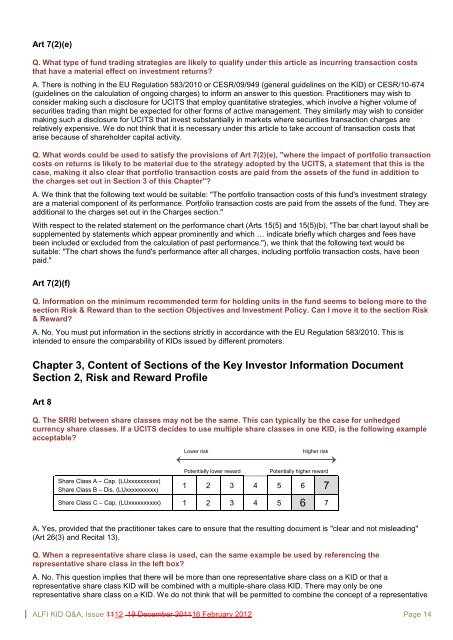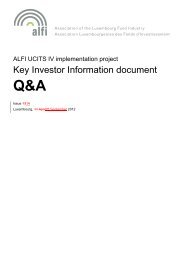Q&A - Alfi
Q&A - Alfi
Q&A - Alfi
You also want an ePaper? Increase the reach of your titles
YUMPU automatically turns print PDFs into web optimized ePapers that Google loves.
Art 7(2)(e)<br />
Q. What type of fund trading strategies are likely to qualify under this article as incurring transaction costs<br />
that have a material effect on investment returns?<br />
A. There is nothing in the EU Regulation 583/2010 or CESR/09/949 (general guidelines on the KID) or CESR/10-674<br />
(guidelines on the calculation of ongoing charges) to inform an answer to this question. Practitioners may wish to<br />
consider making such a disclosure for UCITS that employ quantitative strategies, which involve a higher volume of<br />
securities trading than might be expected for other forms of active management. They similarly may wish to consider<br />
making such a disclosure for UCITS that invest substantially in markets where securities transaction charges are<br />
relatively expensive. We do not think that it is necessary under this article to take account of transaction costs that<br />
arise because of shareholder capital activity.<br />
Q. What words could be used to satisfy the provisions of Art 7(2)(e), "where the impact of portfolio transaction<br />
costs on returns is likely to be material due to the strategy adopted by the UCITS, a statement that this is the<br />
case, making it also clear that portfolio transaction costs are paid from the assets of the fund in addition to<br />
the charges set out in Section 3 of this Chapter"?<br />
A. We think that the following text would be suitable: "The portfolio transaction costs of this fund's investment strategy<br />
are a material component of its performance. Portfolio transaction costs are paid from the assets of the fund. They are<br />
additional to the charges set out in the Charges section."<br />
With respect to the related statement on the performance chart (Arts 15(5) and 15(5)(b), "The bar chart layout shall be<br />
supplemented by statements which appear prominently and which … indicate briefly which charges and fees have<br />
been included or excluded from the calculation of past performance."), we think that the following text would be<br />
suitable: "The chart shows the fund's performance after all charges, including portfolio transaction costs, have been<br />
paid."<br />
Art 7(2)(f)<br />
Q. Information on the minimum recommended term for holding units in the fund seems to belong more to the<br />
section Risk & Reward than to the section Objectives and Investment Policy. Can I move it to the section Risk<br />
& Reward?<br />
A. No. You must put information in the sections strictly in accordance with the EU Regulation 583/2010. This is<br />
intended to ensure the comparability of KIDs issued by different promoters.<br />
Chapter 3, Content of Sections of the Key Investor Information Document<br />
Section 2, Risk and Reward Profile<br />
Art 8<br />
Q. The SRRI between share classes may not be the same. This can typically be the case for unhedged<br />
currency share classes. If a UCITS decides to use multiple share classes in one KID, is the following example<br />
acceptable?<br />
Lower risk<br />
Higher risk<br />
Share Class A – Cap. (LUxxxxxxxxxx)<br />
Share Class B – Dis. (LUxxxxxxxxxx)<br />
Potentially lower reward<br />
Potentially higher reward<br />
1 2 3 4 5 6 7<br />
Share Class C – Cap. (LUxxxxxxxxxx) 1 2 3 4 5 6 7<br />
A. Yes, provided that the practitioner takes care to ensure that the resulting document is "clear and not misleading"<br />
(Art 26(3) and Recital 13).<br />
Q. When a representative share class is used, can the same example be used by referencing the<br />
representative share class in the left box?<br />
A. No. This question implies that there will be more than one representative share class on a KID or that a<br />
representative share class KID will be combined with a multiple-share class KID. There may only be one<br />
representative share class on a KID. We do not think that will be permitted to combine the concept of a representative<br />
ALFI KID Q&A, Issue 1112, 19 December 201116 February 2012 Page 14

















